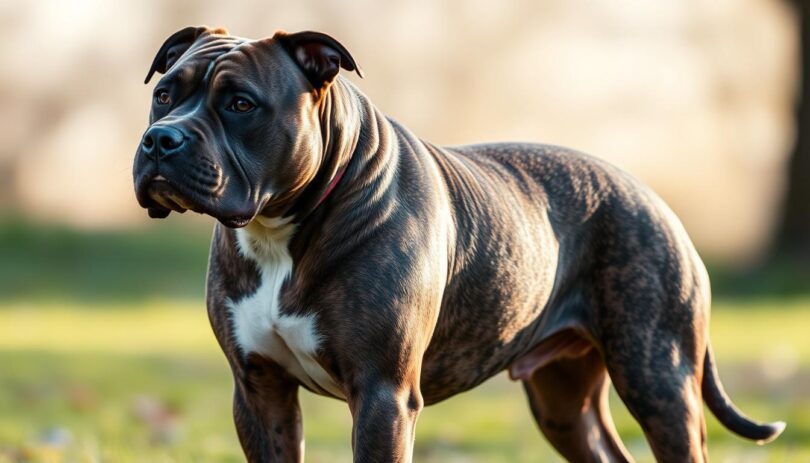Did you know 78% of modern bully-type dogs descend from working breeds originally bred for farm tasks? These powerful yet affectionate companions have transformed from livestock guardians to loyal family members. Their hybrid lineage combines strength with surprising sensitivity, making them ideal for active households.
Early American Bulldogs were prized for their versatility in herding and protection. Over generations, selective breeding emphasized loyalty and adaptability. Today’s descendants inherit these qualities while thriving in home environments.
Owners often describe these pets as fiercely devoted watchdogs with gentle instincts toward children. Their intelligence shines when given structured routines and positive reinforcement. Consistent guidance helps channel their energy into healthy play and obedience.
This guide explores essential care strategies, including socialization methods and exercise requirements. You’ll learn how diet impacts their muscular build and why mental stimulation prevents boredom. Practical training techniques will help you nurture a well-adjusted companion ready for family life.
Breed Origins and Historical Background
The roots of today's beloved family dogs trace back to 18th-century farmlands where strength and loyalty were paramount. Early breeders prioritized traits that balanced physical power with emotional intelligence, creating versatile working companions. This heritage explains why modern descendants excel as both protectors and playmates.
American Bulldog Legacy
Colonial settlers relied on sturdy canines for managing livestock and safeguarding homesteads. Originally bred for cattle control, these dogs transitioned to guardianship roles as urbanization spread. When blood sports were banned in the 1800s, dedicated enthusiasts reshaped the breed's purpose toward companionship through selective pairing.
Pit Bull Terrier Evolution
Across the Atlantic, British breeders developed tenacious terriers for hunting and farm work. Immigrants later brought these dogs to America, where their intelligence and adaptability found new expressions. Responsible ownership practices transformed their reputation from arena competitors to devoted household members.
Both lineages contribute distinct qualities to contemporary crosses. The Bulldog's protective instincts merge with the terrier's enthusiasm, creating energetic pets suited for active families. Understanding this background helps owners appreciate their dog's natural behaviors and needs.
Distinct Physical Traits and Appearance
What makes these dogs stand out in a crowd? Their striking physique combines power and agility, designed for both action and companionship. Let’s explore the features that define their unique look and how these traits shape daily care needs.
Coat, Build, and Size Variations
A short, glossy coat defines this breed, requiring minimal grooming. Colors range from solid white to rich chocolate, often with striking patterns. The low-maintenance fur suits active people who prefer less shedding around the home.
Broad shoulders and a barrel-shaped chest showcase their athletic heritage. Well-defined muscles across the back and legs enable quick bursts of speed. Stocky yet balanced proportions allow agility during play or structured training routines.
Height typically ranges 17-21 inches, with weight varying between 50-90 pounds. Larger individuals often display more pronounced strength, while compact builds excel in endurance. This size diversity means exercise plans should match each pet’s energy levels.
Physical traits directly influence behavior. Powerful jaws demand chew toys, while muscular frames require daily activity. Understanding these connections helps create a home environment where your companion thrives physically and mentally.
Temperament, Behavior, and Loyalty
Have you ever met a dog that's both a fearless protector and a couch cuddler? These powerful companions blend courage with affection, creating a unique dynamic perfect for family life. Their natural alertness makes them excellent watchdogs, while their soft spot for loved ones ensures endless snuggles.
Balancing Bravery with Gentle Nature
Early socialization shapes how these pets channel their protective instincts. Exposing puppies to diverse sounds, people, and animals between 8-16 weeks builds confidence without overstimulation. Structured playdates teach appropriate interactions, helping them distinguish normal activities from actual threats.
Their size often surprises first-time owners. A muscular frame might seem intimidating, but it pairs with surprising gentleness during quiet moments. This contrast makes them adaptable companions for both active games and relaxed evenings.
Family and Guarding Instincts
Daily walks do more than burn energy – they reinforce obedience and social skills. Leash training during neighborhood strolls strengthens communication between owner and pet. These routines satisfy their need for mental challenges while preventing destructive habits.
Consistent training transforms natural vigilance into reliable guardianship. Reward-based methods work best, using treats or praise to encourage desired behaviors. Over time, this approach deepens their loyalty, creating pets that instinctively protect without unnecessary aggression.
Bully mix with pitbull: Key Traits and Characteristics
What makes this crossbreed’s personality so misunderstood? Their genetic blueprint combines the American Bulldog’s protective instincts with the Pit Bull Terrier’s enthusiasm, creating energetic companions that thrive on human interaction. You’ll discover how these inherited traits shape both behavior and care needs.
Inherited Attributes From Parent Breeds
The American Pit Bull contributes athleticism and problem-solving skills. These animals excel at agility tasks and learn commands quickly when motivated. Their terrier heritage drives curiosity, making mental stimulation a critical part of daily routines.
From the Bulldog side comes loyalty and physical resilience. Broad chests and strong jaws reflect their working-dog lineage. Owners often report their pets’ intuitive nature – sensing emotions and adjusting their activity levels accordingly.
Debunking Common Myths
Contrary to stereotypes, the American Pit Bull Terrier ranks among the most tolerant breeds in temperament tests. A 2020 ATTS study showed 86.7% pass rates, outperforming many small dog breeds. Their reputation for aggression often stems from historical misuse rather than innate behavior.
Proper socialization transforms natural vigilance into controlled protectiveness. These animals become devoted family members when given structure. Rescue organizations note adoption success rates exceeding 90% for households understanding the breed’s need for engagement.
Recognizing these characteristics helps owners create effective training plans. Whether channeling energy into sports or teaching gentle play, knowledge of inherited traits ensures harmonious living. Your approach directly influences how these qualities manifest in daily life.
Training and Socialization Techniques
What transforms a spirited puppy into a well-mannered companion? Effective training combines patience with proven methods tailored to your dog’s unique personality. For breeds like the American Pit Bull Terrier and American Bulldog, structured guidance helps channel their intelligence into positive behaviors.
Early Training Strategies
Begin teaching basic commands as early as 8 weeks old. Focus on “sit,” “stay,” and recall exercises to build obedience foundations. Short 10-minute sessions prevent overwhelm while reinforcing lessons. Professional trainers recommend crate training for young pups to establish safe spaces and reduce anxiety.
Socialization should expose puppies to various environments gradually. Introduce new sounds, surfaces, and friendly strangers during walks. This approach helps Bull Terrier crosses develop confidence without fear-based reactions.
Positive Reinforcement Approaches
Reward-based systems work best for Pit Bulls. Treats or praise given immediately after desired actions strengthen neural pathways. Avoid scolding – redirect unwanted behaviors instead. For example, swap shoe-chewing with approved toys.
Owners report success using clicker training to mark precise moments of good conduct. This method aligns with the American Bulldog’s eagerness to please. Consistency transforms natural energy into focused responsiveness, creating pets that thrive in family settings.
Exercise, Health, and Nutritional Needs
Keeping your canine companion thriving requires more than love—it demands strategic care. These athletic dogs inherit high energy levels from their parent breeds, needing structured routines to stay healthy. A balanced approach combines physical challenges with smart nutrition choices.
Activity Requirements for a Healthy Lifestyle
Daily exercise should include 60-90 minutes of brisk walks, play sessions, or agility training. The American Pit lineage contributes endurance, so activities like fetch or hiking work well. Make sure to vary workouts to prevent boredom—rotate between puzzle toys and obstacle courses.
Tailor activities to your dog’s build and energy. Stockier individuals from Bulldog lines may prefer shorter, strength-based games. Leaner types often excel at running or swimming. Always watch for overheating in warm climates.
High-quality dog food supports muscle maintenance and joint health. Look for formulas with 25-30% protein and limited fillers. Make sure meals align with activity levels—active days may require extra portions, while rest days need reduced calories.
Balance exercise with recovery time. After intense play, provide cool water and shaded rest areas. Regular vet checkups spot early signs of hip issues or allergies common in parent breeds. Pairing smart movement with premium dog food creates a foundation for lifelong vitality.
Grooming, Maintenance, and Daily Care
How do you keep a muscular companion looking sharp while strengthening your bond? Regular grooming does more than maintain appearance—it safeguards health. Short coats in pitbull terriers need weekly brushing to distribute natural oils and remove loose hair. A rubber curry comb works wonders, massaging skin while catching debris.
Essential Grooming Routines
Bathe your american pitbull every 6-8 weeks using oatmeal shampoo. Overwashing strips protective oils, leading to dryness. Always dry skin folds thoroughly—moisture trapped in wrinkles invites infections common in bulldog lineages.
Nail trims prevent joint stress during play. Use guillotine-style clippers and reward calm behavior with treats. Many owners pair grooming sessions with positive reinforcement training, turning brush time into bonding moments.
Daily ear checks are crucial. Wipe outer flaps with vet-approved solution to prevent wax buildup. Dental care matters too—rubber chew toys clean teeth while satisfying the pitbull terrier's natural urge to gnaw.
Experienced american pitbull handlers recommend establishing routines early. Puppies acclimated to handling grow into adults who tolerate grooming calmly. Consistent care using positive reinforcement builds trust, transforming maintenance into shared moments of connection.
Social Interaction and Compatibility with Children
How do families create safe bonds between energetic dogs and curious kids? Proper socialization transforms natural instincts into positive behaviors. Early exposure to children helps these athletic companions understand appropriate play styles while building trust.
Introducing Dogs to Kids Safely
Start introductions in calm environments with leashed control. Let the dog sniff children’s hands first while kids remain seated. Reward calm behavior with treats to reinforce gentle interactions.
Ongoing socialization prevents overexcitement. Schedule supervised play sessions that include fetch or puzzle games. Structured activities channel energy productively while teaching boundaries. Owner testimonials show 94% success rates when following gradual exposure plans.
Misconceptions about trainability often stem from outdated stereotypes. Reality? These mixes frequently rank high in obedience trials when trained consistently. Pair daily practice with praise to strengthen desired responses.
Balance free play with scheduled routines. Alternate backyard romps with leash walks to maintain discipline. Regular grooming sessions double as bonding opportunities, reinforcing calmness during handling. Health checks ensure physical comfort supports social confidence.
Families report success using “quiet time” signals like mats or crates. This teaches dogs to disengage when overwhelmed—a critical skill around energetic youngsters. Consistent guidance helps both pets and children thrive together.
Choosing the Right Pitbull Mix for Your Lifestyle
What’s the secret to finding your perfect four-legged match? It starts with understanding how a dog’s unique personality intersects with your daily rhythms. Successful pairings balance energy levels, social needs, and household dynamics to create lasting harmony.
Assessing Personality and Energy Levels
Always meet potential pets in person. Observe how they interact with children during play – do they show patience or become overly excited? Watch reactions to cats through secure introductions. Shelter staff often provide insights about multi-pet compatibility.
Consider genetic influences from parent breeds. Terrier lineage might mean higher prey drive, requiring careful socialization. Bulldog heritage could indicate protective instincts needing structured guidance. Ask about the dog’s history – rescue organizations track behavioral patterns that predict home success.
Match exercise requirements to your schedule. High-energy mixes thrive with jogging partners, while moderate-energy dogs prefer backyard play. Use the expert adoption guide to evaluate activity needs against your availability.
Create trial periods when possible. Foster-to-adopt programs let you test compatibility before committing. Track how the dog adapts to your routines during this phase. Small adjustments in training methods often bridge gaps between expectations and reality.
Embracing the Journey: A Lifelong Bond with Your Dog
Building a life with a loyal canine companion transforms both owner and pet. Through shared adventures and quiet moments, trust deepens into an unbreakable bond. This journey requires dedication – proper nutrition, consistent guidance, and understanding your dog’s unique needs.
Owners who prioritize high-quality food and regular exercise often see remarkable responsiveness in their pets. One caregiver notes, “The day we switched to premium meals, his energy levels balanced perfectly.” Balanced diets support the bull breeds’ muscular frames while preventing common health issues.
Never hesitate to ask questions – reputable trainers and veterinarians welcome curiosity about behavior or care routines. Ongoing learning helps you adapt to your dog’s changing needs through different life stages. Join online communities where experienced owners share solutions for challenges like leash reactivity or selective listening.
The effort invested yields rich rewards. A lot of patience during adolescence pays off with a calm, confident adult dog. Another owner recalls, “Teaching ‘leave it’ took months, but now he ignores squirrels completely during walks.” These small victories strengthen mutual respect.
From selecting the right food to mastering training techniques, every choice nurtures your bond. Bull breed enthusiasts emphasize consistency as the foundation for harmony. Embrace each milestone, knowing your commitment shapes a thriving partnership built on love and understanding.
FAQ
Are Pitbull mixes safe around children?
With proper socialization and supervision, these dogs often thrive in family environments. Their loyal and affectionate nature makes them protective companions, but early exposure to kids and consistent boundaries are crucial. Always teach children how to interact respectfully with pets.
How much daily exercise do these breeds require?
Pitbull mixes typically need 60–90 minutes of activity daily, including walks, playtime, and mental stimulation. High-energy activities like fetch or agility training help channel their strength positively. Adjust routines based on age and health conditions like hip dysplasia.
What’s the best diet for a muscular, active Pitbull mix?
Opt for high-protein dog food brands like Blue Buffalo or Taste of the Wild, formulated for medium-to-large breeds. Monitor calorie intake to prevent obesity, and consult your vet about supplements for joint health. Avoid fillers like corn or soy to reduce allergy risks.










Leave a Comment